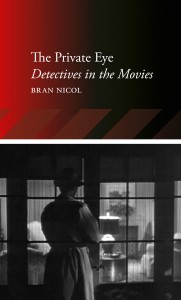The Private Eye
The Private Eye: Detectives in the Movies by Bran Nicol (Reaktion, 2013). 224 pages. ISBN: 978-1780231020 (paperback), £14.95
 About the reviewer: Dr Catherine Haworth, Centre for the Study of Music, Gender and Identity (MuGI), University of Huddersfield. Catherine Haworth specialises in film music. Her doctoral research investigated the role of music and sound in Hollywood crime films, focusing on how the soundtrack engages with the construction of agency for female characters in films released by RKO Radio Pictures during the 1940s. She has taught at the Universities of Leeds, Liverpool and Sheffield, and joined the Huddersfield staff in 2011. Catherine has contributed papers at numerous conferences, published on gender and music in film noir, James Bond, and female detective films, and acted as guest editor to a 2012 gender and sexuality special edition of Music, Sound and the Moving Image. For a list of publications, click here.
About the reviewer: Dr Catherine Haworth, Centre for the Study of Music, Gender and Identity (MuGI), University of Huddersfield. Catherine Haworth specialises in film music. Her doctoral research investigated the role of music and sound in Hollywood crime films, focusing on how the soundtrack engages with the construction of agency for female characters in films released by RKO Radio Pictures during the 1940s. She has taught at the Universities of Leeds, Liverpool and Sheffield, and joined the Huddersfield staff in 2011. Catherine has contributed papers at numerous conferences, published on gender and music in film noir, James Bond, and female detective films, and acted as guest editor to a 2012 gender and sexuality special edition of Music, Sound and the Moving Image. For a list of publications, click here.
E-mail: c.m.haworth@hud.ac.uk
F ighting crime, seducing women, and pounding the ‘mean streets’ of the city, the private investigator is a staple of detective film and fiction and often heralded for his desirably detached masculinity. In The Private Eye, Bran Nicol argues that this viewpoint overemphasises the virile agency of the detective over his involvement with the interior, ‘private’ realm: a space with the potential to emasculate given its connections with feminising domesticity and morally ambiguous employment in personal investigation, surveillance, and undercover snooping. He traces the eye’s history from the 1930s to the present day, although the heftiest sections focus upon film noir, which provides the angst-ridden, existentialist, and shadowy urban landscapes where the private investigator comes closest to feeling at home. Although these sections cover some well-trodden ground, their focus on the investigator as protagonist as well as plot device offers interesting ways to conceptualise the links between literary and cinematic detectives, the various cycles of film noir, and the twists and turns of the crime, mystery, and thriller genres. This history is organised as a tripartite model: classic eyes of the 1940s and 50s (The Maltese Falcon; Murder, My Sweet; The Big Sleep); the ‘neo-modernist’ investigators of the 1970s who update the archetype to address new audiences and cultural shifts (Chinatown; Shaft; The Long Goodbye); and, from the 1980s onwards, the self-referential and often parodic detectives of the ‘postmodern’ school (Dead Men Don’t Wear Plaid; Kiss Kiss Bang Bang).
ighting crime, seducing women, and pounding the ‘mean streets’ of the city, the private investigator is a staple of detective film and fiction and often heralded for his desirably detached masculinity. In The Private Eye, Bran Nicol argues that this viewpoint overemphasises the virile agency of the detective over his involvement with the interior, ‘private’ realm: a space with the potential to emasculate given its connections with feminising domesticity and morally ambiguous employment in personal investigation, surveillance, and undercover snooping. He traces the eye’s history from the 1930s to the present day, although the heftiest sections focus upon film noir, which provides the angst-ridden, existentialist, and shadowy urban landscapes where the private investigator comes closest to feeling at home. Although these sections cover some well-trodden ground, their focus on the investigator as protagonist as well as plot device offers interesting ways to conceptualise the links between literary and cinematic detectives, the various cycles of film noir, and the twists and turns of the crime, mystery, and thriller genres. This history is organised as a tripartite model: classic eyes of the 1940s and 50s (The Maltese Falcon; Murder, My Sweet; The Big Sleep); the ‘neo-modernist’ investigators of the 1970s who update the archetype to address new audiences and cultural shifts (Chinatown; Shaft; The Long Goodbye); and, from the 1980s onwards, the self-referential and often parodic detectives of the ‘postmodern’ school (Dead Men Don’t Wear Plaid; Kiss Kiss Bang Bang).
The Private Eye situates the lone gumshoe as a key player and thematic motif in an evolving and frequently self-referential body of films where the lines between good and evil, them and us, and public and private are blurred both within and outside the diegesis. Given the puzzle-driven nature of mystery plots, the detective commonly acts as our guide to complex and confusing surroundings; not only giving him agency and authority over the unfolding text but also emphasising his own compromised nature (distinguishing the hardboiled eye from the tradition of cosy, intellectual ‘armchair’ investigators). Nicol usefully extends the boundaries of his study in places, including amateurs caught up in circumstances beyond their control and cops whose professional role is usurped by personal interest – but all of these protagonists, like the classic cinematic eye, are men. Whilst this gender imbalance is reflective of much hardboiled and crime fiction, it excludes female amateur or accidental sleuths (including those who provide investigative support in classic noirs such as Stranger on the Third Floor and Phantom Lady, as well as more familiar characters like Nancy Drew, Hildegarde Withers and Miss Marple). These women also disrupt the traditional conflation of manliness and investigative prowess that Nicol critiques elsewhere, and would provide an interesting addition to his arguments.
 Learning on Screen
Learning on Screen